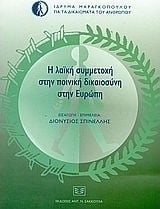
Author(s): director: D. Spinellis
The participation of laymen in the administration of criminal justice is always at the center of discussions at an international level. Indeed, in various countries there are developments in their respective legislation, as well as in practice, the more important ones being the following:
– In countries in which a pure jury system is in force, its real value in the adjudication of criminal cases is very low.
– In some of those countries, such system is criticised for being costly, for its usually arbitrary outcomes, as well as its marginal implementation.
– There is a tendency to limit the participation of laymen in some countries, in which a system of mixed jury courts applies. On the contrary, in other ones the varying forms of participation of laymen is functional and applies in a large number of criminal cases.
– In any case, in most States in continental Western Europe, the pure jury system, in which it had been gradually introduced during the 19th century, has been criticised by most of the theorists of criminal procedure as outdated, time-consuming, expensive and often leading to unintended and unfair results. As a result, the pure jury system was replaced in most countries in Western Europe, in the course of the 20th century, by a system of mixed courts, pertaining both ordinary judges and laymen. As per the ratio of the two elements in these mixed courts one may identify a significant variety.
– On the other hand, the former socialist states in Eastern and Central Europe, as well as in States of the former Soviet Union, there is a tendency of introducing or reintroducing a pure jury system. The latter tends to partially replace the mixed jury courts existing since the era of actually existing socialism and being consisted of a professional judge as president and two laymen.
– Similarly, in Spain, and in other countries in South America, where former dictatorial regimes were replaced by democratic ones, the institution of laymen participating in criminal justice was introduced, either in the form of jury or in the form of mixed courts or under both forms.
As it can be deduced, the jury system is usually introduced in States in which there is disbelief towards professional judges. […] (An excerpt of the introduction)
